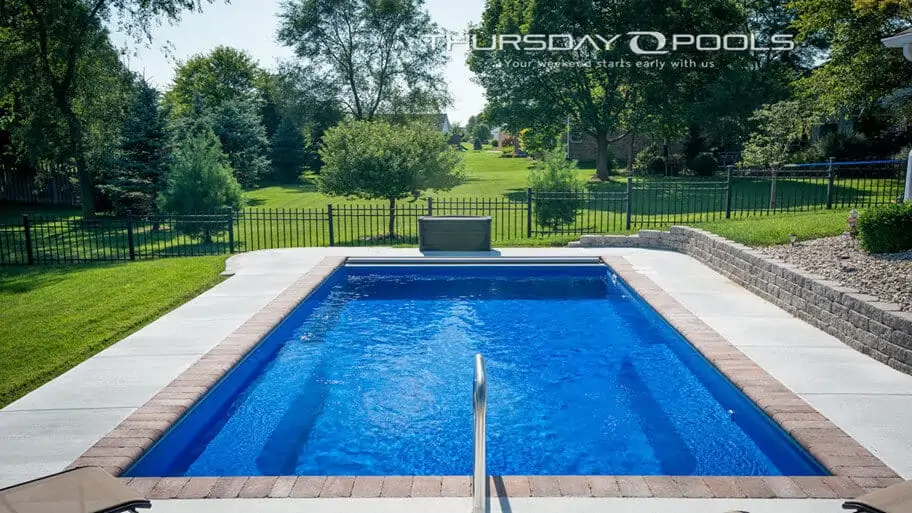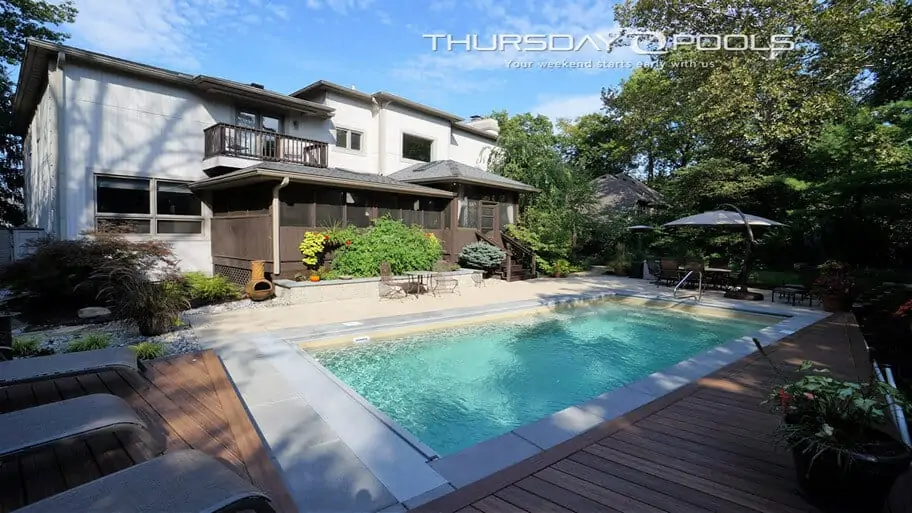I mean, I’ll admit it. I thought I knew a decent amount about vinyl liner pools since everyone in the Midwest has been in one at one time in their life. Honestly, the truth is, I didn’t even know the half of it until I started working here but it’s a good thing we are all about education!
With this in mind, we here at Royal Pools and More recognize that there are so many details below the surface that many of you may not know. So, we’ve created a quick blog guide that maps out the pros, cons, and manufacturing process of vinyl liner pools—and what you’ll find may surprise you.
But before we get there, it is important to know the major components of a vinyl liner pool first.
Components of a Vinyl Liner
1. Pool Base
The base of the pool (the surface underneath the liner) is made of vermiculite, aka pool crete.
Vermiculite used in pools is slightly different than the actual mineral itself, as it is a mixture of the mineral and Portland cement. It is slightly softer than cement, making it more forgiving than say concrete when or if it cracks under the liner. Lending to a softer edge than the sharp edge of concrete.
Vermiculite is the optimal material for a firm pool floor that doesn’t rough up the liner too much.
Other options for pool floor bases are:
Concrete – which is very rough on the surface
Grout– which is also very rough on the surface
Sand – which is just too soft and can leave divots. Sand is more commonly used on above-ground pools.
2. Wall Panels
The wall surface of the pool is made up of wall panels and you can choose from these materials:
- Steel
- Aluminum
- Polymer (plastic)
- Wood
The panels are usually 42 inches tall (3 ft., 6 in.). In combination with the two-inch thick floor, this gives you a standard shallow end depth of 40″.
3. Liner
The liner is made of vinyl. Hence, the name vinyl liner. The liner itself is the actual entire surface of the pool with exception of specific staircases.
The thickness of a liner is measured in mils, with 1 mil being 1/1000th of an inch. This is NOT to be confused with a millimeter. They are not the same.
Typically, vinyl liners can come in 20, 27, 28, or 30 mils in thickness.
While we use mils to measure liner thickness, it can also be measured in gauges. If a liner is measured in gauges, you should ask for the measurement in mils to make the process easier.
Another feature of liners that you should be aware of is that they will be either embossed or non-embossed.
- Embossed liners—High and low points create variation in thickness; the liner feels soft and squishy
- Non-embossed liners—Same thickness throughout; not as soft or comfortable as embossed liner.
If you do choose a thicker liner, you will be spending more.
4. Steps
When considering steps for a vinyl liner pool, keep in mind that you have three options:
- White Plastic Steps—Attached to the walls and look like a staircase; the most common option
- Vinyl Over Steps—Premade and placed on the wall of the pool. The liner will be formed to fit over the steps
- Ladder—Mini-ladder that hangs over the edge of the pool.
5. Coping
Coping is the border around the top of the pool that creates a transition from the pool itself to the patio surrounding it. You have a few options for coping, such as:
- Aluminum C-Channel—Bolted to the top of the pool as a barrier between the pool and patio
- Cantilevered—Concrete poured up to the area where the patio and pool meet; the concrete becomes the barrier between the pool and patio
- Flat-Mount—Flat and connects directly to the liner of the pool
Pros of Vinyl Liner Pools
1. Low Upfront Cost
Vinyl liner pools have the lowest upfront cost from $60,000-$85,000. Therefore, vinyl liners can fit into lower budgets.
2. Installation Time
It typically takes between 4-8 weeks to install a vinyl liner and although it takes a few more weeks than fiberglass, it takes significantly less time than concrete pools.
3. Customization
One of the best advantages of vinyl liner pools is that they are 95% customizable. Customizing the shape, size, and depths of the pool does increase the cost, but if you have certain specifications, a vinyl liner can almost always accomplish them.
4. Smooth Surface
The surface of the pool is almost entirely smooth except for the area where the liner is fused together. Even so, when compared to a concrete pool, a vinyl liner is much gentler on the skin.
5. Do-It-Yourself
If you so choose, you can install the liner pool yourself, which cuts around $10,000-$15,000 off the overall price. However, doing so may take longer than it would if you have a professional do it.
Cons of Vinyl Liners
1. Durability
Since liners are less than a millimeter in thickness, it can be easy to tear or puncture them.
You will also have to replace the liner every 4-9 years since natural wear and tear can take its toll on the pool. Therefore, you will have to factor in $6,000-$6,500 each time the liner must be replaced.
2. Warranty
Warranties are often presented with the advertisement that liners are fully covered. However, there is a lot of “fine print” that you may not be aware of.
For example, you may find that:
- Warranties only fully cover a manufacturer defect in the liner for the first 2-5 years
- After 2-5 years, the warranty becomes prorated and you become responsible for covering a higher percentage of the cost
3. Not Too Compatible with Salt Systems
Saltwater systems are only usable if your vinyl liner pool has polymer wall panels. If your vinyl liner pool has metal wall panels, you shouldn’t use a saltwater system since it can corrode the walls if not properly grounded.
4. Algae Growth
Although vinyl liner pools are mostly non-porous, there are some areas where algae can grow.
These areas may include:
- Where the steps attach to the pool
- Lighting areas
- Areas where the liner is fused together
How Are Vinyl Liner Pools Made?
As previously mentioned, it takes about 4-8 weeks to complete the installation of a vinyl liner pool.
Now, since it’s important for you to know how the pool is made, we’ve outlined the different steps to fully complete a vinyl liner pool.
Step 1: Vinyl Liner Excavation (1-2 Days)
Before the actual process of building the pool can begin, the builders will need to excavate the area where your pool will be located.
The hole is typically dug about 30 inches larger than what the pool will be in perimeter.
Step 2: Wall Panel Assembly (1 Day)
This step requires the builders to bolt and secure the wall panels together. In other words, the perimeter of the pool is built.
Any steps are built into the pool during this step as well.
Step 3: Concrete Footing (1/2 Day)
Once the perimeter is assembled, concrete is laid around the outside of the walls to firmly keep them in place.
Step 4: Plumbing (1 Day)
The pump and filter system is installed. This allows for the water in the pool to be filtered, cleaned and possibly sanitized if you so choose (keep in mind that sanitization increases cost).
Step 5: Base Installation (1-2 Days)
The earth that is exposed within the perimeter of the pool is covered with vermiculite or grout. Then, the builders smooth out the material and allow it to dry.
Step 6: Liner Installation (1 Day)
The liner is laid onto the vermiculite or grout base. It is then connected to a track that is attached to the top of the wall panels.
Once the liner is connected around the entire perimeter of the pool, the builders remove any wrinkles that may be present.
The builders then begin filling the pool with water and cut areas for lights, skimmers, jets, or steps.
Then, the builders continue to fill the pool with water.
Step 7: Patio Installation
This step takes the longest to complete and before it can begin, a bonding inspection needs to be completed.
Once completed, the builders can begin the landscaping process that will surround the pool.
Basically, your yard can be transformed in this process, which is why it takes the longest to complete.
Step 8: Pool Start-Up
Water chemistry is tested to make sure the pH level of the water is balanced and safe to swim in.
The filter is then cleaned until the water is clear and ready for you to begin using!
Is This Everything You Need to Know?
By now, you have a much more in-depth understanding of how a vinyl liner pool is made as well as its pros and cons.
However, there is still a ton for you to learn, especially in comparison to fiberglass and concrete pools. You can find this information Here!








